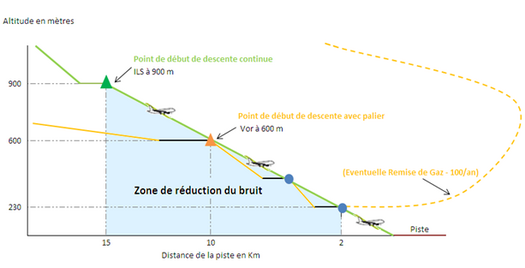Rumore
Rumore
As part of its Sustainable Development Plan, Paris-Beauvais Airport has set up an air quality measurement system. This system guarantees reliable measurement of the emissions generated by the airport's activities and provides local residents with transparent information.
Noise measurement
Since 2009, five noise monitoring stations have been installed near the airport :
- “Cité des Fleurs “ neighbourhood in Beauvais
- Plouy-Saint-Lucien
- Laversines
- Tillé
- Troissereux
Annual information meetings are organized with these municipalities to keep local residents informed.
In addition, there is a mobile station for occasional measurement campaigns carried out at the request of municipalities. Each measurement campaign is systematically followed by feedback meetings.
Noise insulation assistance
Airlines operating from Paris-Beauvais Airport are required ti pay a noise pollution tax (TNSA) representing an average of €20 per takeoff. This tax funds a noise insulation aid program for residents close to the airport.
The insulation assistance is based on a Noise Disturbance Plan (PGS), available for consultation at the Beauvais, Tillé, and Troissereux town halls. Residents living in the areas covered by this plan may be eligible for the aid under certain conditions.
To benefit from this aid, residents must follow a process outlined by the Environmental Code, which includes:
- Eligibility verification;
- Acoustic diagnosis;
- Obtaining multiple quotes;
- Review by the Consultative Commission for Resident Assistance (CCAR);
- Notification of aid allocation;
- Completion of the work;
- Disbursement of the aid.
The administrative and technical management of this program is handled by Espace9, a company selected by the Beauvais Airport Management and Operations Company (SAGEB). Espace9 brings extensive experience from major French airports to ensure clarity and security for residents involved in the process.
To ensure effective noise insulation, SAGEB also offers:
- Assistance from a project management advisor for residents;
- Training sessions on acoustic insulation for companies, in partnership with the Oise Chamber of Trades and Crafts.
As of December 31, 2015, of the 500 homes identified within the PGS:
- 271 eligible applications for insulation aid were being processed;
- Insulation work had been completed in 169 homes.
Affected neighbourhood can check the eligibility of their home for this aid by sending a written request for information to Espace9. The request must get the following attached elements :
- A cadastral plan
- A copy of the building permit or a certificate of construction delivered by the town hall.
The request, then, needs to be sent to :
Espace9
1140, Rue Ampère ACTIMART, Building 1B, Entrance A
13851 Aix-en-Provence Cedex 3
Further information on noise insulation assistance , contact Espace9 : 0 800 284 667
Reducing noise from flight paths
To reduce noise pollution caused by air traffic, the main solution is to adjust flight paths to avoid villages near the airport. Paris-Beauvais Airport, in collaboration with local municipalities and residents, makes ongoing efforts.
The Civil Aviation Authority and the Prefect of Oise have approved the creation of a working group within the Environmental Advisory Commission. This group, consisting mainly of local officials and resident associations, is focused on studying solutions to reduce noise pollution. In the medium term, the goal is for all departure flight paths to benefit from GPS-guided navigation, preventing their dispersion.
[Translate to Italien:] Adaptation des méthodes de pilotage au décollage
The procedures followed by pilots and air traffic controllers have also been revised to encourage quicker climbs to maximum altitude, further reducing noise pollution.
Planes now gain up to an additional 300 meters in altitude when passing over or near villages close to the airport.
Adaptation of landing procedures

Since 2010, landings are conducted using a continuous descent approach, thanks to an advanced and precise Instrument Landing System (ILS). continuous descent helps to avoid noise pollution caused by engine throttle adjustments, which are typically used during stepped descents.
Continuous descent also delays the deployment of landing gear and flaps, reducing aerodynamic noise and vibrations.
To lessen the noise perceived by residents near the airport, the use of thrust reversers — which help with braking by reversing the engine airflow — has been minimized to the bare essentials.
Additionally, the use of auxiliary power units for stationary aircraft is more strictly regulated.
Noise levels associated with flights
AEROVISION is a website designed to visualize commercial air traffic at Paris-Beauvais Airport, as well as the associated noise levels. For security reasons mandated by the relevant authorities, the traffic is displayed with a 30-minute delay compared to real-time.
To access the website, click here.

